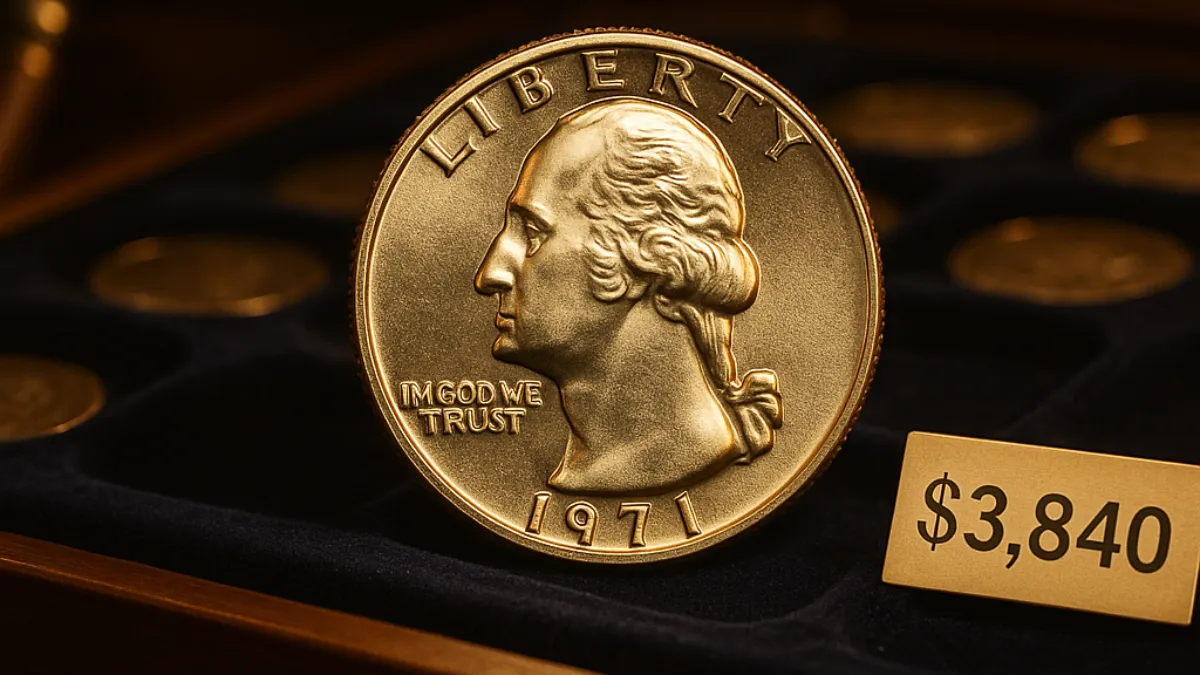Are you curious about the 1971 Washington quarter? Do you wonder whether your coin is worth any money?
The 1971 Washington quarter is a favorite among coin collectors. Its value can vary depending on its condition and grade.
This guide will help you explore the 1971 quarter’s background, design, and notable errors that might significantly increase its value.
Let’s dive in!
1971 Quarter Value Chart
| Mint Mark | Good | Fine | Extremely Fine | Uncirculated |
|---|---|---|---|---|
| 1971 (No Mint Mark) | $0.30 | $0.30 | $0.30 | $1,250 |
| 1971-D | $0.30 | $0.30 | $0.30 | $1,100 |
| 1971-S (Proof) | – | – | – | $7,574 |
1971 Quarter Value Guides
Let’s take a closer look at each type of 1971 Washington quarter to understand their potential value:
- 1971 No-Mint Mark Quarter
- 1971-D Quarter
- 1971-S Proof Quarter
1971 No-Mint Mark Quarter Value
Philadelphia minted around 109 million of these quarters in 1971. Because of the high mintage, they are not rare, and many are still in circulation.
Coins from this mint were often poorly struck, so finding one in excellent condition can be a challenge. Still, circulated coins typically sell for around $0.30 to $0.85.
Uncirculated examples in Mint State (MS) 63 are valued around $8, while MS65 grades may go for $10. The highest known grade, MS67, has seen sales as high as $3,840.
1971-D Quarter Value
Denver produced over 250 million quarters in 1971—more than any other mint that year. These coins generally show better quality than the Philadelphia issues.
Circulated 1971-D quarters sell for $0.30 to $0.85. In Mint State 63, their value is around $8. Rare MS68 specimens have reached auction prices of $4,560.
1971-S Proof Quarter Value
Proof quarters from 1971 were struck in San Francisco, with around 3.2 million produced. These coins are more precisely made and usually have a shiny, detailed finish.
Depending on the grade and cameo quality, prices range from $2.30 for PR60 coins to over $7,000 for rare Deep Cameo examples.
In 2023, a PR70 example with a red-brown patina sold for $4,000, while a PR69 Deep Cameo brought in $7,574.
1971 Quarter Errors
While most 1971 quarters are common, a few with minting errors can be worth hundreds or even thousands of dollars.
1971 Doubled Die Reverse
This error happens when the die shifts during production, creating a double image on the coin. Look for doubling on the date or the word “LIBERTY.” Values can range from $10 to $100, depending on the intensity of the doubling.
1971 Broad Struck Error
These occur when a coin is struck outside its retaining collar, leading to a coin that’s wider than usual. A well-centered broad strike can sell for around $400 if the design is fully visible.
1971 Clipped Planchet Error
This error leaves a noticeable “bite” out of the coin’s edge. Look for signs like a curved gap, a weak rim opposite the clip, and stretched design features. These coins can fetch between $10 and $100, with higher prices for examples where the date is still visible.
History Of The 1971 Quarter
The Washington quarter debuted in 1932 to honor George Washington’s 200th birthday. Although it was meant to be a one-year commemorative coin, it ended up replacing the Standing Liberty quarter permanently.
The original obverse was designed by John Flanagan, based on a sculpture by Jean-Antoine Houdon. The 1971 design still features this portrait, but coins minted from 1965 onward were made of copper-nickel instead of silver.
In 1971, more than 371 million Washington quarters were struck across all three mints—making the coin widely available.
How To Identify 1971 Quarter?
Understanding a coin’s details can help you know if yours is valuable.
Obverse Design
The front side of the coin shows a left-facing portrait of George Washington. You’ll also see:
- “LIBERTY” at the top
- “IN GOD WE TRUST” on the left
- The year “1971” at the bottom
Reverse Design
The back features an eagle with spread wings, perched on arrows, and two olive branches below. “E PLURIBUS UNUM” appears above the eagle’s head, with “UNITED STATES OF AMERICA” and “QUARTER DOLLAR” encircling the edges.
Other Features Of The 1971 Quarter
- Composition: 75% copper, 25% nickel over a pure copper core
- Weight: 5.67 grams
- Diameter: 24.30 mm
- Edge: Reeded
Only Denver-minted coins carry the “D” mintmark, visible on the obverse near Washington’s ponytail. Quarters from Philadelphia and San Francisco (proofs) have no mintmark.
Where Is The Mint Mark On A 1971 Washington Quarter?
Only Denver quarters have a mintmark. Look for the letter “D” on the front of the coin, just next to Washington’s hair tie.
Does The 1971 Quarter Have Silver?
No. After 1964, silver was removed from standard circulation coins. The 1971 quarter is made of copper-nickel and contains no silver.
Why Are 1971 Quarters Rare?
Most 1971 quarters are not rare. However, ones with unique errors can be valuable. While over 350 million were produced, a few standout examples can still be collectible and worth much more than face value.
FAQ
What is the value of a 1971 quarter?
The value of a 1971 quarter depends on its condition and mintmark. Typically, they are worth around $0.30 to $1 in circulated condition. Uncirculated coins can be worth several dollars, with the highest-grade coins reaching over $3,800.
Are there rare 1971 quarters?
While most 1971 quarters are common, errors such as the 1971 Doubled Die Reverse or Clipped Planchet errors can make a coin more valuable, ranging from $10 to several hundred dollars.
How can I tell if my 1971 quarter is valuable?
Look for high-quality examples or any minting errors such as doubling, broad strikes, or clipped planchets. Coins in excellent, uncirculated condition also tend to be more valuable.
What is the most valuable 1971 quarter?
The most valuable 1971 quarter is the 1971-S Proof quarter in perfect condition (PR70), which has been sold for over $7,500.

